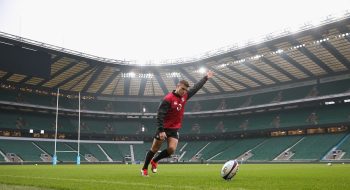
LONDON, ENGLAND – The autumn internationals will be an unmitigated disaster for one of the two sides facing off at Twickenham on Saturday. If England fall, they will have lost to all three of the major Southern Hemisphere powers at home, and their only victory in the last seven tests will be their lackluster win against a distracted Samoan side. If Australia lose, questions will immediately arise about the direction of Michael Cheika’s squad in advance of the World Cup. While England still have the Six Nations to get the house in order, the only tests in front of Cheika’s Wallabies are in next year’s abbreviated Rugby Championship. The match is granted even more significance because England and Australia share a group in next year’s World Cup. Unless Wales can overcome their Southern Hemisphere hoodoo, the match between the sides on October 3 will probably crown the group winner, and grant a path to the final that doesn’t include the All Blacks.
England have made three changes to the squad that dispatched Samoa. George Ford retains his place as the starting fly-half. His display against Samoa apparently inspired confidence in the England coaching staff. He is partnered with Billy Twelvetrees, returning from the international wilderness after losing form in the middle part of the year. Owen Farrell takes a place on the bench for the first time in Lancaster’s reign. Ford offers a different set of liabilities, and his defensive prowess will be under far more pressure against the Wallabies than it was lining up across from Samoa. If Ford can produce an all-round display, Farrell may have to get used to the view from the bench. Ben Youngs is the other part of the pivot, with Danny Care dismissed back to Harlequins for the remainder of the campaign. Australia’s Bernard Foley and Nick Phipps will oppose Ford and Youngs. While Phipps ran a beautiful support line to grab his first international try, it papered over the cracks with far too many commentators. He was not too assured at the base of the ruck, and his box kicking must improve. Foley does not yet inspire confidence amongst Australia supporters, but he can nail down his place with a creative performance.

Much of the pre-match discussion has surrounded the perceived weakness in Australia’s front five. England run absurdly deep at all positions in the forward pack, while Australia are forced to name Benns Robinson and Alexander on the bench, who have continually failed to impress over the last year. James Slipper and Sekope Kepu start as Australia’s props. They have performed creditably so far this autumn. As Graham Rowntree noted, the Wallabies are “no mugs” in the scrum, and always seem to perform above the sum of their parts. Courtney Lawes and Dave Attwood will try to cement a growing partnership. Though Attwood impressed against the All Blacks in June and in the first test, he probably hasn’t done enough to assert a claim above Joe Launchbury or Geoff Parling if either of the two are healthy come the Six Nations. He needs to put in a massive shift to change that line of thinking. Sam Carter and Rob Simmons will counter. Their main job will be to disrupt the England line-out, which has been extraordinary all autumn. The battle between Chris Robshaw and Michael Hooper also bears keeping an eye on. Hooper has been the Wallabies’ stand-out over the past year, and with David Pocock close to returning from injury, every match must be solid.
England are deservedly the bookmakers’ favorites to win, following their close and fortuitous victory at Twickenham last year. Judging by their form so far this autumn, they may come away with another unimpressive victory, but the win itself will be what matters on the Test stage. Australia seem to have lost their way this cycle, though this remains is a team capable of performing extraordinarily at the oddest times. It will be a desperately hard fought-affair. I see England coming away with a narrow win, with no more than a try separating the sides.

